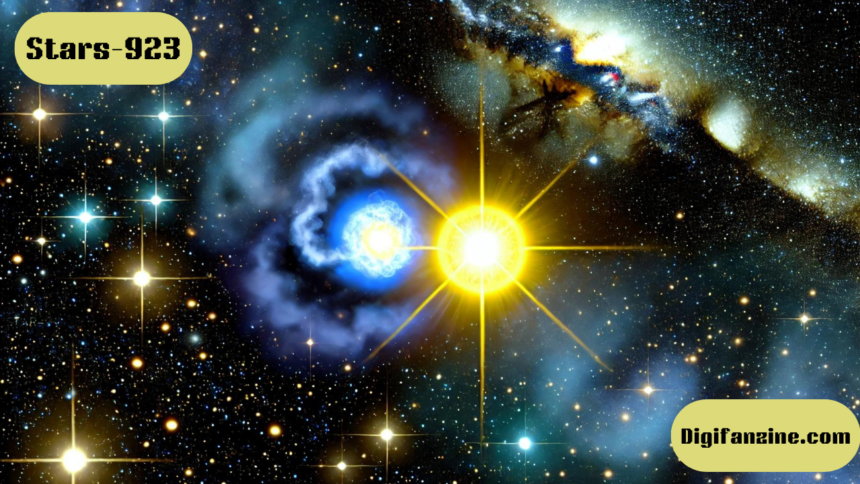Stars-923, a distant celestial object, has captured the imagination of astronomers and stargazers alike. From its stunning brightness to its role in stellar evolution, this star offers a glimpse into the complex life cycle of stars in our universe. In this detailed article, we will explore everything about Stars-923, its significance in scientific discovery, its characteristics, and its cultural importance. We’ll also delve into frequently asked questions (FAQs) about Stars-923 to help enhance our understanding of this cosmic wonder.
What Is Stars-923?
Stars-923 is a unique celestial object located millions of light-years away from Earth. It belongs to a distant star system that has become the subject of intense research within the astronomical community. The star’s brightness, composition, and behavior have set it apart from other stars, making it an essential object of study for astronomers.
Stars-923 is currently in its main sequence phase, during which it burns hydrogen in its core through nuclear fusion. This process generates the light and heat that make Stars-923 visible, even from great distances. As it ages, Stars-923 is expected to undergo significant changes, eventually transforming into a red giant and potentially ending its life as a neutron star or black hole.
The Significance of Stars-923 in Astronomy
The study of Stars-923 is crucial in advancing our understanding of the universe. Scientists have used powerful telescopes such as the Hubble and James Webb space telescopes to capture high-resolution images and data of the star. These observations provide valuable insights into the lifecycle of stars and the formation of celestial bodies in distant parts of the galaxy.
Stars like Stars-923 are essential in studying stellar evolution because they offer a complete view of stars’ stages—from their formation to their eventual death. Stars-923 is particularly fascinating because it is believed to be massive enough to either collapse into a neutron star or form a black hole in the final stages of its life.
Characteristics and Behavior of Stars-923
Stars-923 is characterized by its vibrant colors, which range from deep blue to bright yellow, indicating a wide temperature range. Its brightness and massiveness are much greater than our Sun’s, making it a standout object in the night sky.
The star also exhibits a unique rotational speed, contributing to strong magnetic field generation. These magnetic fields can influence nearby stars and planets, making Stars-923 an essential player in the dynamics of its star system.
One of the most exciting aspects of Stars-923 is the potential presence of exoplanets around it. By studying the fluctuations in its brightness, astronomers hope to discover planets that may be located in its vicinity. This discovery could open up new chapters in the search for habitable planets and extraterrestrial life.
The Evolution of Stars-923
Stars, including Stars-923, go through several phases in their lifecycle. Stars-923 is currently in the main sequence stage, burning hydrogen to produce energy. This phase is relatively stable, but as Stars-923 ages, it will exhaust its hydrogen fuel and transition into the red giant phase. During this phase, the star’s core contracts while its outer layers expand, causing it to swell significantly.
Eventually, Stars-923 will face one of two possible fates: it will either collapse into a dense neutron star or become a black hole if it is massive enough. The process by which a star dies depends heavily on its mass, and scientists are eagerly studying Stars-923 to determine its eventual fate.
Observing Stars-923
Observing Stars-923 is a rewarding experience for amateur astronomers and stargazers, though it requires powerful equipment. Due to its great distance from Earth, Stars-923 is not visible to the naked eye, but with the help of telescopes, it can be spotted under the right conditions.
The best way to view Stars-923 is by finding a location with minimal light pollution, such as a rural area far from city lights. A star chart or astronomy app will also help locate Stars-923 in the night sky. Giving your eyes time to adjust to the darkness will also enhance your ability to observe this distant star.
Cultural Significance of Stars-923
Stars have always held a place of importance in human culture, and Stars-923 is no exception. Throughout history, stars have been used for navigation, storytelling, and spiritual guidance. Ancient civilizations often associated stars with deities and used their movements to mark important events.
In modern times, Stars-923 inspires artists, poets, and writers. Its beauty and mystery have made it a popular subject in scientific literature and culture. Whether it’s through artwork or astronomical documentaries, Stars-923 serves as a symbol of the endless possibilities that the universe holds.
Scientific Discoveries Related to Stars-923
Recent technological advancements have enabled scientists to study Stars-923 in greater detail. Telescopes equipped with high-resolution cameras and spectrographs have allowed astronomers to determine the star’s age, temperature, and chemical composition.
One of the key findings about Stars-923 is its unique spectral lines, which provide clues about the star’s evolutionary stage. These lines also help scientists model how stars like Stars-923 change over time and contribute to our understanding of stellar evolution.
Moreover, gravitational waves detected from nearby merging stars are shedding light on the system’s mass distribution, further contributing to the growing body of knowledge about Stars-923 and similar celestial objects.
Future Research on Stars-923
As technology advances, astronomers are optimistic about the future of research on Stars-923. Upcoming space missions and next-generation telescopes will allow for even more detailed observations of this star and its surroundings. Scientists hope to uncover new information about the star’s behavior, its potential for hosting exoplanets, and its role in the broader dynamics of the galaxy.
The study of Stars-923 is far from over, and each discovery brings us closer to understanding the mysteries of the universe.
FAQs About Stars-923
Q1: What is Stars-923?
Stars-923 is a distant star located millions of light-years away from Earth. It is currently in the main sequence phase of its lifecycle and is known for its brightness and unique characteristics.
Q2: Can I see Stars-923 with the naked eye?
No, Stars-923 is too far away to be seen with the naked eye. However, it can be observed with a powerful telescope, especially in areas with low light pollution.
Q3: What is the significance of studying Stars-923?
Studying Stars-923 helps astronomers better understand stars’ lifecycles, from their formation to their eventual death. It also provides insights into stellar evolution and the formation of black holes and neutron stars.
Q4: What phase is Stars-923 in?
Stars-923 is currently in the main sequence phase, where it burns hydrogen in its core. As it ages, it is expected to transition into a red giant.
Q5: Are there any planets around Stars-923?
While no confirmed evidence exists of planets orbiting Stars-923, astronomers are studying its light fluctuations to determine if exoplanets may be present.
In conclusion,
Stars-923 remains one of the most captivating celestial objects in our galaxy. Its role in stellar evolution, cultural significance, and profound contribution all contribute to our deeper understanding of the cosmos. The future of astronomy holds exciting possibilities for discovering even more about this cosmic wonder.
Also Read: Mastering the Art of drawing:a4z_-ymtkr8= cat and Simple = Drawing Ideas







